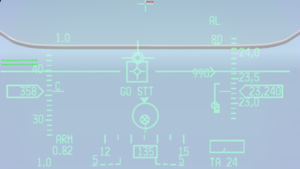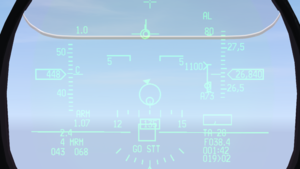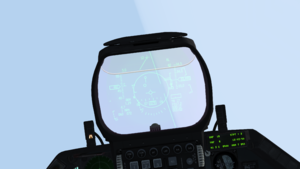Difference between revisions of "BVR tactics"
| Line 52: | Line 52: | ||
{{#ev:youtube|https://www.youtube.com/watch?v=B0bEYyxEtd8||left|BVR medium drag defense|frame}} | {{#ev:youtube|https://www.youtube.com/watch?v=B0bEYyxEtd8||left|BVR medium drag defense|frame}} | ||
{{#ev:youtube|https://www.youtube.com/watch?v=nzvC_PmOq_8||left|BVR defensive press|frame}} | {{#ev:youtube|https://www.youtube.com/watch?v=nzvC_PmOq_8||left|BVR defensive press|frame}} | ||
| + | |||
| + | =RAYGUN calls= | ||
| + | "RAYGUN (Position/Heading/Altitude): Indicating a radar lock-on to unknown aircraft. A request for a “BUDDY SPIKE” reply from friendly aircraft meeting these parameters. " (Multiservice tactics, Techniques, and Procedures, 25) | ||
| + | |||
| + | A raygun call contains the following information to be communicated from the targeted over comms. | ||
| + | XXX for XXX: A call about position in relation to the bullseye first giving the bearing from the bullseye to the target then the range (reference this article) | ||
| + | Angels (XX): A call telling altitude; angels 1 is a 1000ft so angels 07, for example, would be 7000ft | ||
| + | Climbing/Descending: additional information that can be added, simply is the target climbing or descending. | ||
| + | |||
| + | A raygun call is meant to IFF (Identify Friend or Foe) without the use of Datalink, TGP, or the MK1 eyeball. If you are unable to IFF by any of the previously mentioned means a raygun call may be made. The raygun call is made over UHF tactical communications (usually UHF 17 - 359.300) to ensure all flights can hear the call and respond accordingly. It is the responsibility of the fighter that has a contact locked up to IFF and make sure there are no Blue on Blue incidents. The call and response to the call is to be made clearly and loudly over UHF in a clear and concise manner. This follows basic brevity protocol but for raygun calls it is especially important to speak clearly and also for other flights to listen and respond if they are the one locked up. | ||
| + | |||
| + | ==Fighter locking an unknown target up== | ||
| + | If unable to IFF with normal means make the Raygun call. Make the Raygun call clearly and concisely over UHF 17. Wait about~5-8 seconds for a response, if none materializes make the call again and wait another ~5-8 seconds. Don't shoot purely on a raygun call. | ||
| + | |||
| + | Think: | ||
| + | *Are there any friendlies near there? | ||
| + | *Should I IFF via another means before shooting? | ||
| + | *How reliable is the raygun call? Did the responding flight confirm they are the ones being locked up or was it simply a generic buddy spike? | ||
| + | *Can I safely wait to get a visual IFF or will it result in my death or another flights death? | ||
| + | *Make sure to call your missile launch on a Raygun target - EX: fox 1 bulls 198 for 18 angels 19 climbing. | ||
| + | |||
| + | ==Friendly being locked up== | ||
| + | Am I the target of the Raygun call? Check RWR (is there a radar locking me up and is it a friendly radar signature?). Check own Bullseye (is the called bullseye my own?). Check Angels (is that my angels?). Respond to call if necessary. | ||
| + | |||
| + | Don't rely solely on the RWR the locking radar may be in a RWR blind zone. Make sure that at a minimum to respond with your angels and confirm your position. You may be locked up by a friendly other than the one making the raygun call if you don’t confirm you position. If you make the friendly think he is locking up a friendly instead of a bandit it may escape and kill a friendly down the road. | ||
| + | |||
| + | ==Limits== | ||
| + | As alluded to in one of the bullet points in "Friendly being locked up" there is a big limit to raygun calls. If there is a big airbattle that gets chaotic and people start using a lot of raygun calls with limited information breeds confusion. In the confusion of battle a raygun call may go unheard even after the second call so in chaotic furballs always try to IFF via another means. Use the raygun call as an advisory that the target may be hostile and act accordingly. Overall the rayun call is a good IFF measure but only if you get the needed information. | ||
| + | |||
| + | ==Example== | ||
| + | |||
| + | You are a #2 in a flight scanning the sky when you pick up a contact appear near a friendly flight. Call out the contact to your flight lead. | ||
| + | |||
| + | "Raygun Raygun, 176 for 18, angels 14, climbing." | ||
| + | |||
| + | Wait for response: | ||
| + | |||
| + | Someone responds with: "Buddy Spike 176 for 18, angels 14, climbing" | ||
| + | |||
| + | Scenario A end game: | ||
| + | |||
| + | In this situation you have locked up a friendly and you should break the lock immediately! Then respond with your callsign and “Buddy Lock”. | ||
| + | |||
| + | Scenario B end game: | ||
| + | |||
| + | Make a second call after ~5-8 seconds. If still no response tell your flight lead who can then contact the flight near the likely hostile to confirm if the unknown contact is hostile and if so coordinate the defense of both flights. | ||
{{Nav UOAF_A2A}} | {{Nav UOAF_A2A}} | ||
Revision as of 23:39, 12 May 2017
Contents
Learning objectives
- Loft missiles
- Use TWS to lock multiple targets
- Know how to crank
- Home on Jam techniques
- When to Chuck your Spears doc.
Learning files
BVR techniques
BVR techniques differ each in each engagement according to your capabilities, the targets capabilities and secondary factors like known SAM locations.
If you are able to out range the enemy fighter with your BVR missiles(with for example AIM-120B/C against the Russian AA-10) you can spend more time guiding your missile to the target, whereas in engagements with equal capabilities(for example AIM-120C against AA-12) you need to start your defensive turn as soon as you can get your missile off the rail.
When engaging a target it is favourable if you are at high altitude and high speed prior to the engagement as your missiles will be able to travel further while you will have a lot of altitude you can convert into energy when doing your defensive turn(see BFM).
In the image above you can see the typical FCR symbology when engaging a hostile aircraft. On the right of the display you can see a triangle, which indicates the current range of the bogey in relation to the different kill brackets you can see below.
The same symbology is also available in the HUD:
As you close distance to the target the triangle will move down on your HUD/FCR, when it reaches the first large bracket it will be within maximum range of your missile.
At this point the missile could theoretically hit our target, but only if the target keeps flying at the same altitude, bearing and speed. Against a fighter such a shot will most likely not hit, engaging larger aircraft like bombers, tankers or AWACS might yield a kill.
In this last picture the target triangle has moved down the large bracket towards the box at the bottom, this is the high pK(probability of kill) box. While he is still outside of our pK box we can safely take the first shot and discourage our target from turning in to us and firing a missile of his own. If we wait a little longer and close more distance he will be within our high pK box, at which point the target will not be able to evade your missile by simply turning away and kicking the afterburner. The only thing that can save him now is defensive manoeuvres coupled with lots of chaff.
Basic procedure in a BVR engagement
- Approach at high speed and altitude
- Get as close as possible to the high pK box, keep the max range of the enemy aircraft in mind
- Loft your missile by pulling up at a 20° angle while being in full afterburner
- FIRE!!
- Turn left or right and put the target on your beam(3/9 o'clock) while keeping the target within your radar gimbal
- Guide your missile until it either goes active itself(AIM-120C), it hits the target(AIM-7) or you have to turn defensive to evade enemy missile.
Scuby from the 31st VFS has created a few BVR instructional videos on YouTube you can watch to familiarise yourself with some advanced BVR tactics. In his case he is up against a opponent with similar capabilities so you can see him turning defensive earlier than you would have to against a less capable opponent.
RAYGUN calls
"RAYGUN (Position/Heading/Altitude): Indicating a radar lock-on to unknown aircraft. A request for a “BUDDY SPIKE” reply from friendly aircraft meeting these parameters. " (Multiservice tactics, Techniques, and Procedures, 25)
A raygun call contains the following information to be communicated from the targeted over comms. XXX for XXX: A call about position in relation to the bullseye first giving the bearing from the bullseye to the target then the range (reference this article) Angels (XX): A call telling altitude; angels 1 is a 1000ft so angels 07, for example, would be 7000ft Climbing/Descending: additional information that can be added, simply is the target climbing or descending.
A raygun call is meant to IFF (Identify Friend or Foe) without the use of Datalink, TGP, or the MK1 eyeball. If you are unable to IFF by any of the previously mentioned means a raygun call may be made. The raygun call is made over UHF tactical communications (usually UHF 17 - 359.300) to ensure all flights can hear the call and respond accordingly. It is the responsibility of the fighter that has a contact locked up to IFF and make sure there are no Blue on Blue incidents. The call and response to the call is to be made clearly and loudly over UHF in a clear and concise manner. This follows basic brevity protocol but for raygun calls it is especially important to speak clearly and also for other flights to listen and respond if they are the one locked up.
Fighter locking an unknown target up
If unable to IFF with normal means make the Raygun call. Make the Raygun call clearly and concisely over UHF 17. Wait about~5-8 seconds for a response, if none materializes make the call again and wait another ~5-8 seconds. Don't shoot purely on a raygun call.
Think:
- Are there any friendlies near there?
- Should I IFF via another means before shooting?
- How reliable is the raygun call? Did the responding flight confirm they are the ones being locked up or was it simply a generic buddy spike?
- Can I safely wait to get a visual IFF or will it result in my death or another flights death?
- Make sure to call your missile launch on a Raygun target - EX: fox 1 bulls 198 for 18 angels 19 climbing.
Friendly being locked up
Am I the target of the Raygun call? Check RWR (is there a radar locking me up and is it a friendly radar signature?). Check own Bullseye (is the called bullseye my own?). Check Angels (is that my angels?). Respond to call if necessary.
Don't rely solely on the RWR the locking radar may be in a RWR blind zone. Make sure that at a minimum to respond with your angels and confirm your position. You may be locked up by a friendly other than the one making the raygun call if you don’t confirm you position. If you make the friendly think he is locking up a friendly instead of a bandit it may escape and kill a friendly down the road.
Limits
As alluded to in one of the bullet points in "Friendly being locked up" there is a big limit to raygun calls. If there is a big airbattle that gets chaotic and people start using a lot of raygun calls with limited information breeds confusion. In the confusion of battle a raygun call may go unheard even after the second call so in chaotic furballs always try to IFF via another means. Use the raygun call as an advisory that the target may be hostile and act accordingly. Overall the rayun call is a good IFF measure but only if you get the needed information.
Example
You are a #2 in a flight scanning the sky when you pick up a contact appear near a friendly flight. Call out the contact to your flight lead.
"Raygun Raygun, 176 for 18, angels 14, climbing."
Wait for response:
Someone responds with: "Buddy Spike 176 for 18, angels 14, climbing"
Scenario A end game:
In this situation you have locked up a friendly and you should break the lock immediately! Then respond with your callsign and “Buddy Lock”.
Scenario B end game:
Make a second call after ~5-8 seconds. If still no response tell your flight lead who can then contact the flight near the likely hostile to confirm if the unknown contact is hostile and if so coordinate the defense of both flights.
{{#invoke:Navbox|navbox}}
{{#invoke:Navbox|navbox}}



